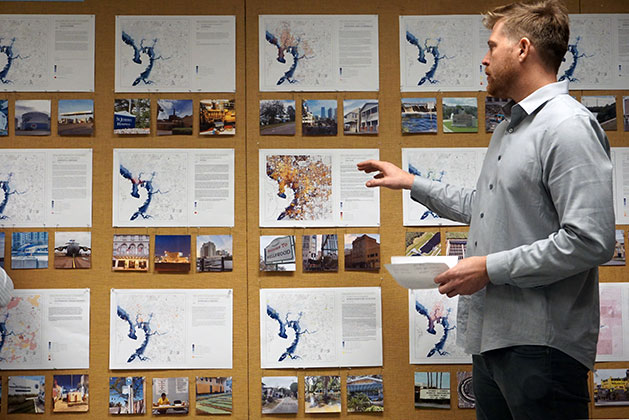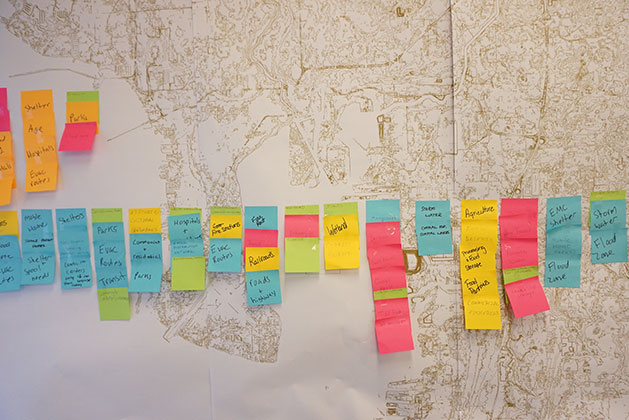USF Community Design Researchers Conduct Comprehensive Climate Vulnerability Study in Hillsborough County
Thursday, September 12, 2019

USF architecture student Austin Jenquine presents his maps showing vulnerable areas within Hillsborough County.
The USF Florida Center for Community Design and Research, part of the College of The
Arts School of Architecture and Community Design, is conducting the Hillsborough County Community Vulnerability
Study, a comprehensive study of sea level rise and flooding vulnerabilities in the
county.
Sponsored by Hillsborough County and conducted in partnership with the USF College
of Public Health, the study is an important asset to climate adaptation planning in
Hillsborough and beyond as the researchers systematically and comprehensively document
sea level rise and flooding vulnerabilities as they relate to the built environment,
local ecology, and public health.
Taryn Sabia, USF associate professor of research, and Brian Cook, USF visiting assistant
professor of research, are two researchers working on the project.
“Our project with Public Health really brings to light the vulnerabilities of the
people that are living in these places and the things that they depend on for their
daily lives or for evacuation purposes or sustenance or whatever,” said Cook. “As
a partnership, we’re looking at how built environment, including ecology, is affected
and then how that interrelates with the public’s health.”
Climate change is challenging municipalities around the world on how to adapt to best
serve their populations. Its effects are widespread and include sea level rise due
to thermal expansion of the world’s oceans and the addition of water from melting
land ice. Climate change also brings more extreme weather events, such as hurricanes,
and tidal flooding (also known as sunny day flooding), which brings water inland beyond
historic levels.
The Community Vulnerability Study aligns with climate issues documented in the United
States’ Fourth National Climate Assessment. Completed in late 2018, it gives a complete
look at impact, risk, and adaptation associated with climate change. It documents
the immediate and long-term effects of climate change and how climate change challenges the
natural, built, and social environments in interconnected systems.
The study states that only through careful consideration of these systems can the United
States effectively manage climate risk.
Recent meetings between USF Florida Center researchers and the county brought together community leaders and a variety of local units such as utilities, transportation, parks and recreation, sustainability, utilities management, and emergency management for an unprecedented collaboration to assess each unit’s concerns that pertain to sea level rise and flooding. Tampa Bay U.S. Representative Kathy Castor is a partner in the project and has visited USF on two occasions.
In the spring of 2019, the USF School of Architecture and Community Design brought together a innovative interdisciplinary studio class to work on the project. The class’s 24 graduate students represented four academic units across campus: the College of Public Health, the College of Arts and Sciences School of Public Affairs, the College of Engineering, and the School of Architecture and Community Design.
At the end of the semester, students presented their final projects to county officials. The national chair and regional chair of the NAACP were in attendance as was Peter Stiling, USF assistant vice provost for strategic initiatives.
The hands-on research and design opportunity provided the students with experience working between disciplines. The experience is directly relevant to the climate issues that will continue to shape their careers in public health, engineering, urban planning, and community design.
“This is going to be what they end up working on,” said Taryn Sabia, associate professor of research at the USF School of Architecture and Community Design. “Based on the research we’ve done, we’re pretty confident it’s not an easy fix and it’s not a short-term one either.”
Cook, Sabia, and the graduate student researchers began the project by conducting research on the known vulnerabilities of Hillsborough County. They examined existing government studies, academic articles, newspaper articles, and other case studies on flood vulnerabilities in Tampa Bay.
They then used this establishing a Matrix of Vulnerabilities — an aggregated list of systemic and interrelated flooding-related issues in the county. They also included how other municipalities have addressed their perils of flood, as required by the Florida Senate Bill 1094 passed in 2015.

Researchers identify overlapping systems of vulnerability during a Community Vulnerability Study workgroup session. Notes are placed over a topographic map of Hillsborough County.
The team found that most of the existing assessments dealt with properties and structures.
With an interdisciplinary lens, they viewed the county holistically to identify and
assess flooding as it also relates to public health and ecology.
The team summarizes their major findings in the 280-page Community Vulnerability Handbook,
a resource which includes policy language for municipalities who need to address flooding
vulnerabilities as they relate to development and redevelopment planning. The handbook
educates readers on relevant vocabulary, codes, and policies.
By taking a comprehensive approach to development and redevelopment amid a changing
climate, the handbook is an excellent resource for municipalities around the state
and the world who are looking for ways to adapt to a changing climate.
Applying a variety of baseline scenarios to the maps, the researchers identified the
extent of county vulnerabilities, where they are located, and how to reduce risk through
thoughtful design and planning. Their scenarios considered sea level rise projections
through 2045; storm surge from category 1, category 3, and category 5 hurricanes;
and precipitation.
This in-depth assessment offers new insights into specific vulnerabilities in Hillsborough
County. Hotels, for example, are clustered near Tampa Bay and the Hillsborough River.
With a category 3 storm, up to 38% of these hotels are exposed to flooding issues.
Taking into account a public health perspective, the 40,000 to 50,000 people who could
inhabit these hotels will need to be accounted for in an emergency plan. Some may
be travelers from outside the area and be unfamiliar with the threat of hurricanes.
Others may have evacuated from other vulnerable areas in the state. The researchers
say this population must be considered during emergency shelter and evacuation planning.
Another systemic issue the researchers found relates to shelter-in-place policies.
When they mapped housing by year of construction, they found concerning data on people
in older homes who would typically be told to stay in their homes in the case of a
hurricane. People in older homes who are also low income and without access to transportation
present additional challenges.
“For a lot of our historic areas, or even places built before the ‘70s, we have low-income
households who don’t have resources to harden their homes,” said Sabia. “But they
happen to be on higher ground, which means they become shelter-in-place—they’re not
evacuated.”
These are just two examples of the type of systemic and interrelated issues facing
Hillsborough County concerning the perils of flood. With this knowledge, the county
can consider solutions to systemic issues that are practical and can provide the greatest
benefit.
One idea the researchers are looking into is to rely more on community social structure
and community buildings during times of disaster. By offering grants to community
centers, such as churches and recreation centers, to harden their structures, vulnerable
populations could rely more on their local communities and be more self-sufficient
during emergency storm situations. Evacuees could stay in their neighborhood and be
among familiar members of their community.
The researchers will meet again with Hillsborough County officials to discuss the
options for future policies. In April of 2019, the Florida Center for Community Design
and Research won the Tampa Bay Regional Planning Council Future of the Region Award.
In September, the researchers earned a Hillsborough County Planning and Design Award.
When the county-sponsored Community Vulnerability Study ends in the spring of 2020,
the researchers, in collaboration with Delft University of Technology (TU Delft) in
The Netherlands, will continue looking beyond their 2045 assessments to expand their
research to the year 2100.
TU Delft is a world leader in climate research and is home to the number three architecture school in the world.
“They are the mega partner,” said Sabia.
In March of 2019, 20 students from the innovation studio class visited the Netherlands as part of the collaboration to look at The Netherlands’ flood infrastructure and develop a deeper understanding of the concepts involved. With the support of the USF Nexus Initiative, Cook and Sabia will continue the active collaboration between USF and TU Delft.
USF’s involvement with the Hillsborough County Vulnerability study has created an unprecedented body of work that will benefit Hillsborough County and the wider region while acting as an important addition to global climate adaptation research.
“These solutions are not things that have necessarily been looked at,” said Sabia. “We’ve heard a lot about raising street levels in Miami. That’s going to have a lot of negative impacts. We’re trying to be a lot more holistic about systems and how everything is impacting one another.”
Press coverage
Wednesday, October 30, 2019
Tampa Bay Times: Facing a future of flooding, Hillsborough County officials ponder
how to keep communities above water
Florida Politics: Kathy Castor Announces Climate Change Coalition with USF